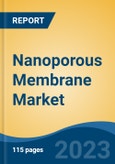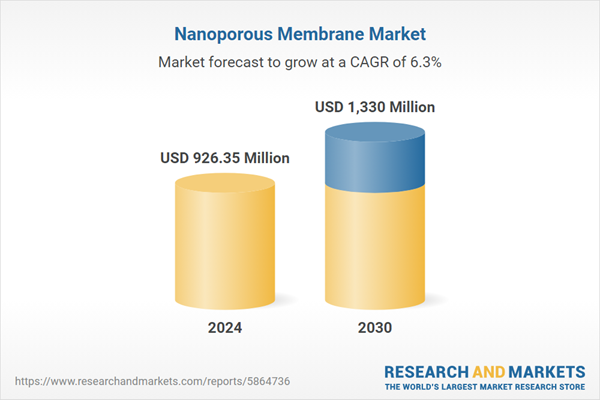Speak directly to the analyst to clarify any post sales queries you may have.
10% Free customizationThis report comes with 10% free customization, enabling you to add data that meets your specific business needs.
As industries face increasing pressure to meet regulatory standards, operational efficiency targets, and sustainability commitments, nanoporous membranes are moving beyond traditional roles to become integrated process solutions. Their deployment is shifting from niche use cases to core process infrastructure, particularly in sectors where purity, resource recovery, and zero-contamination standards are non-negotiable.
Market momentum is being driven by Advanced membrane innovations (e.g., hybrid and smart membranes), Capital investment in water infrastructure and life sciences manufacturing, Rising demand for modular, scalable separation technologies. With a clearly expanding commercial footprint and application scope, the nanoporous membranes market offers significant upside potential for technology providers capable of delivering high-performance, application-specific solutions at industrial scale.
Key Market Drivers
Rising Demand for Water Treatment and Desalination Solutions
The rising demand for water treatment and desalination solutions is one of the most significant and impactful drivers propelling the growth of the Global Nanoporous Membranes Market. As freshwater resources become increasingly strained due to population growth, urbanization, industrialization, and climate change, governments and industries worldwide are turning to advanced filtration technologies to ensure sustainable and safe water supply. Nanoporous membranes are emerging as a critical solution in this landscape, offering superior filtration, efficiency, and adaptability for a range of water purification applications.Across many regions, particularly in Asia-Pacific, the Middle East, and Africa, freshwater sources are under severe stress. A recent analysis of 1,693 global aquifer systems revealed that over one-third experienced annual declines of at least 0.1 meters between 2000 and 2022. Alarmingly, in approximately 30% of these cases, the rate of groundwater depletion accelerated over time, Pollution of rivers and lakes, Overuse of water for agriculture and industry have created an urgent need for alternative and reliable water sources. Nanoporous membranes enable efficient filtration at the molecular level, making them ideal for: Removing contaminants, heavy metals, and pathogens, Producing drinking water from seawater or brackish sources through desalination, Treating and recycling wastewater for industrial and municipal reuse. Their use in such applications is rapidly expanding to meet growing water demands.
By 2025, an estimated 1.8 billion people are projected to live in regions experiencing absolute water scarcity, while nearly two-thirds of the global population could be subjected to significant water stress. Countries facing acute water shortages are heavily investing in desalination infrastructure. For instance, The Middle East leads globally in desalination capacity and is increasingly adopting membrane-based technologies over traditional thermal methods due to energy efficiency and cost-effectiveness. In India and China, urban and coastal regions are also developing seawater desalination plants to support population and industrial growth. Nanoporous membranes, especially those used in reverse osmosis (RO) and nanofiltration (NF), are key components in these plants due to their ability to remove salts and impurities while maintaining water flux and operational longevity.
Government policies worldwide are mandating higher water quality standards and promoting sustainable water use and wastewater reuse. This includes Zero Liquid Discharge (ZLD) regulations in industrial sectors, Effluent treatment mandates for polluting industries like chemicals, textiles, and mining, Incentives for water recycling and reuse. To comply with these standards, industries are adopting membrane-based treatment systems. Nanoporous membranes offer a compact, energy-efficient, and scalable solution, making them a preferred choice for meeting regulatory requirements.
Currently, 55% of the global population resides in urban areas, a figure projected to rise to 68% by 2050, according to newly released data from the United Nations. This urban expansion, driven by both population growth and the ongoing migration from rural to urban regions, is expected to add approximately 2.5 billion people to cities worldwide over the next 25 years and the development of smart city infrastructure are driving demand for decentralized and high-performance water treatment solutions. Nanoporous membranes are well-suited for Point-of-use water filtration systems, Decentralized wastewater treatment plants, Compact, modular purification systems for remote or water-stressed regions. This adaptability further enhances their appeal across both developed and emerging economies.
Key Market Challenges
High Manufacturing and Operational Costs
One of the most significant barriers to the widespread adoption of nanoporous membranes is the high cost associated with production and system integration. Complex fabrication processes involving precise control at the nanoscale require advanced materials and technologies, which are capital-intensive. Raw materials used especially for hybrid and inorganic membranes can be expensive or difficult to source in large quantities. In applications such as desalination or industrial separation, the energy consumption of pressure-driven membrane systems (e.g., reverse osmosis) can be substantial, increasing total cost of ownership. Membranes may need frequent replacement due to fouling or degradation, adding to operational expenses. These cost concerns can deter adoption in price-sensitive markets, particularly in developing regions or small- to medium-sized enterprises (SMEs) that lack capital to invest in premium technologies.Key Market Trends
Integration of Nanoporous Membranes in Next-Generation Energy Technologies
One of the most transformative trends is the emergence of nanoporous membranes as critical enablers in clean and alternative energy systems. With the global push toward decarbonization and energy transition, these membranes are increasingly being used in innovative energy applications such as Hydrogen fuel cells: Nanoporous membranes are being engineered to improve ion conductivity, gas separation, and water management, which are essential for efficient fuel cell operation.Redox flow and lithium-ion batteries Advanced membranes enhance electrolyte separation and safety performance, extending battery life and performance. Carbon capture and storage (CCS) Membranes with tailored pore structures enable selective CO₂ separation from flue gases, offering a more compact and energy-efficient solution than conventional methods. As countries and corporations invest in net-zero targets and renewable infrastructure, the integration of nanoporous membranes in energy technologies is expected to become a high-growth, high-value market segment, creating opportunities beyond traditional water and filtration markets.
Key Market Players
- BASF SE
- Alfa Laval AB
- Applied Membranes Inc.
- AXEON Water Technologies Inc.
- DowDuPont Inc.
- Hunan Keensen Technology Co. Ltd.
- inopor GmbH
- Koch Membrane Systems Inc.
- Pure-Pro Water Corporation
- SiMPore Inc.
Report Scope:
In this report, the Global Nanoporous Membrane Market has been segmented into the following categories, in addition to the industry trends which have also been detailed below:Nanoporous Membrane Market, By Material Type:
- Organic
- Inorganic
- Hybrid
Nanoporous Membrane Market, By Application:
- Water Treatment
- Fuel Cells
- Biomedical
- Food Processing
- Others
Nanoporous Membrane Market, By Region:
- North America
- United States
- Canada
- Mexico
- Europe
- France
- United Kingdom
- Italy
- Germany
- Spain
- Asia-Pacific
- China
- India
- Japan
- Australia
- South Korea
- South America
- Brazil
- Argentina
- Colombia
- Middle East & Africa
- South Africa
- Saudi Arabia
- UAE
Competitive Landscape
Company Profiles: Detailed analysis of the major companies present in the Global Nanoporous Membrane Market.Available Customizations:
With the given market data, the publisher offers customizations according to a company's specific needs. The following customization options are available for the report.Company Information
- Detailed analysis and profiling of additional market players (up to five).
This product will be delivered within 1-3 business days.
Table of Contents
Companies Mentioned
The leading companies profiled in this Nanoporous Membrane market report include:- BASF SE
- Alfa Laval AB
- Applied Membranes Inc.
- AXEON Water Technologies Inc.
- DowDuPont Inc.
- Hunan Keensen Technology Co. Ltd.
- inopor GmbH
- Koch Membrane Systems Inc.
- Pure-Pro Water Corporation
- SiMPore Inc.
Table Information
| Report Attribute | Details |
|---|---|
| No. of Pages | 180 |
| Published | September 2025 |
| Forecast Period | 2024 - 2030 |
| Estimated Market Value ( USD | $ 926.35 Million |
| Forecasted Market Value ( USD | $ 1330 Million |
| Compound Annual Growth Rate | 6.2% |
| Regions Covered | Global |
| No. of Companies Mentioned | 11 |








